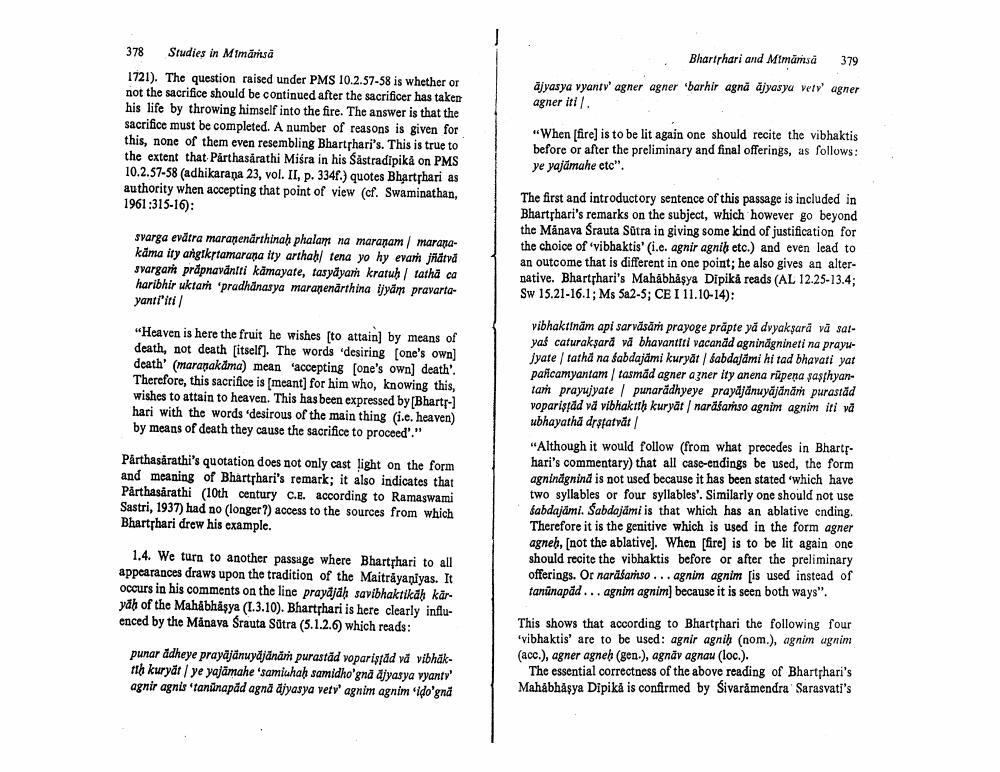________________
Bharthari and Mtmāmså 379 ajyasya vyantv' agner agner "barhir agna ajyasyu vervagner agner itil.
378 Studies in Mimārsā 1721). The question raised under PMS 10.2.57-58 is whether or not the sacrifice should be continued after the sacrificer has taken his life by throwing himself into the fire. The answer is that the sacrifice must be completed. A number of reasons is given for this, none of them even resembling Bhartshari's. This is true to the extent that Párthasarathi Miśra in his Sastradipikä on PMS 10.2.57-58 (adhikarana 23, vol. II, p. 334f.) quotes Bharthari as authority when accepting that point of view (cf. Swaminathan, 1961:315-16):
"When (fire) is to be lit again one should recite the vibhaktis before or after the preliminary and final offerings, as follows: ye yajāmahe etc".
svarga evätra maranenarthinah phalam na maranam maranakāma ity angikatamarana ity arthah/ tena yo hy evan jäärva svargar prapnaväntti kämayate, tasyayarh kratuh / tatha ca haribhir uktar 'pradhanasya marapenarthina lyam pravartayanti'iti/
The first and introductory sentence of this passage is included in Bharthari's remarks on the subject, which however go beyond the Mänava Srauta Sutra in giving some kind of justification for the choice of 'vibhaktis' (i.e. agnir agnib etc.) and even lead to an outcome that is different in one point; he also gives an alternative. Bharthari's Mahâbhâsya Dipika reads (AL 12.25-13.4; Sw 15.21-16.1; Ms 5a2-5; CEI 11.10-14):
"Heaven is here the fruit he wishes [to attain) by means of death, not death [itself). The words 'desiring (one's own) death' (maranakama) mean accepting (one's own] death'. Therefore, this sacrifice is (meant] for him who, knowing this, wishes to attain to heaven. This has been expressed by [Bhartrhari with the words desirous of the main thing (i.c. heaven) by means of death they cause the sacrifice to proceed'."
Parthasarathi's quotation does not only cast light on the form and meaning of Bharthari's remark; it also indicates that Pårthasarathi (10th century C.e. according to Ramaswami Sastri, 1937) had no longer ?) access to the sources from which Bharthari drew his example.
vibhaktinam api sarvāsām prayoge prăpte ya dvyaksarà va salyaś caturak sară vă bhavantti vacanăd agninägnineti na prayujyate / tatha na sabdajāmi kuryat / tabdajāmi hi tad bhavati yat pancamyantam / tasmad agner agner ity anena rūpena sasthyantam prayujyate punaradhyeye prayājānuyājänar purastad voparisfdd và vibhaktih kuryat / narašańso agnim agnim iti vā ubhayatha drspatrāt / "Although it would follow (from what precedes in Bharthari's commentary) that all case-endings be used, the form agninagnina is not used because it has been stated 'which have two syllables or four syllables'. Similarly one should not use fabdajámi. Sabdajami is that which has an ablative ending. Therefore it is the genitive which is used in the form agner agneh, (not the ablative). When [fire) is to be lit again one should recite the vibhaktis before or after the preliminary offerings. Or nardsarso ... agnim agnim [is used instead of tanūnapäd... agnim agnim because it is seen both ways".
1.4. We turn to another passage where Bharthari to all appearances draws upon the tradition of the Maitrayaniyas. It occurs in his comments on the line praydjah savibhaktikah kāryah of the Mahabháşya (1.3.10). Bharthari is here clearly influenced by the Mänava Srauta Sutra (5.1.2.6) which reads:
punar adheye prayājānuyajānāṁ purastad voparistad va vibhakrth kuryāt / ye yajāmahe 'samiuhah samidho'gna ajyasya vyanty' agnir agnis 'tanūnapăd agna ajyasya vetv' agnim agnim Ido'gna
This shows that according to Bharthari the following four "vibhaktis' are to be used: agnir agnih (nom.), agnim ugnim (acc.), agner agneh (gen.), agnāv agnau (loc.).
The essential correctness of the above reading of Bharthari's Mahabhâsya Dipika is confirmed by Sivaramendra Sarasvati's




